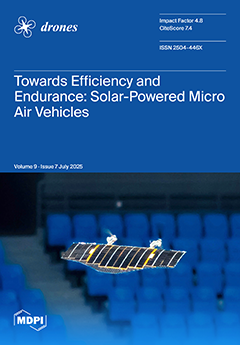In recent years, global agriculture has encountered several challenges exacerbated by the effects of changes in climate, such as extreme water shortages for irrigation and heat waves. Water-deficit stress adversely affects the morpho-physiology of numerous crops, including soybean (
Glycine max L.), which
[...] Read more.
In recent years, global agriculture has encountered several challenges exacerbated by the effects of changes in climate, such as extreme water shortages for irrigation and heat waves. Water-deficit stress adversely affects the morpho-physiology of numerous crops, including soybean (
Glycine max L.), which is considered as promising crop in Bangladesh. Seaweed extract (SWE) has the potential to improve crop yield and alleviate the adverse effects of water-deficit stress. Remote and proximal sensing are also extensively utilized in estimating morpho-physiological traits owing to their cost-efficiency and non-destructive characteristics. The study was carried out to evaluate soybean morpho-physiological traits under the application of water extracts of
Gracilaria tenuistipitata var.
liui (red seaweed) with two varying irrigation water conditions (100% of total crop water requirement (TCWR) and 70% of TCWR). Principal component analysis (PCA) revealed that among the four treatments, the 70% irrigation + 5% (
v/
v) SWE and the 100% irrigation treatments overlapped, indicating that the application of SWE effectively mitigated water-deficit stress in soybeans. This result demonstrates that the foliar application of 5% SWE enabled soybeans to achieve morpho-physiological performance comparable to that of fully irrigated plants while reducing irrigation water use by 30%. Based on Pearson’s correlation matrix, a simple linear regression model was used to ascertain the relationship between unmanned aerial vehicle (UAV)-derived vegetation indices and the field-measured physiological characteristics of soybean. The Normalized Difference Red Edge (NDRE) strongly correlated with stomatal conductance (R
2 = 0.76), photosystem II efficiency (R
2 = 0.78), maximum fluorescence (R
2 = 0.64), and apparent transpiration rate (R
2 = 0.69). The Soil Adjusted Vegetation Index (SAVI) had the highest correlation with leaf relative water content (R
2 = 0.87), the Blue Normalized Difference Vegetation Index (bNDVI) with steady-state fluorescence (R
2 = 0.56) and vapor pressure deficit (R
2 = 0.74), and the Green Normalized Difference Vegetation Index (gNDVI) with chlorophyll content (R
2 = 0.73). Our results demonstrate how UAV and physiological data can be integrated to improve precision soybean farming and support sustainable soybean production under water-deficit stress.
Full article





